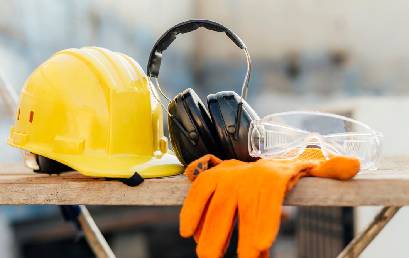
Toolbox Talk on Head Protection – PPE Safety on Falling Objects
Toolbox Talk on Head Protection at Construction Site
Head injuries rank among the most serious yet preventable risks on construction sites. Even a small impact can cause fractures, concussions, or lasting disability.
Imagine a hammer falling from 10 meters can generate a force of 3 kg. Now think what heavier objects can do. Wearing your hard hat properly reduces this impact by around 76%, distributing the force to your neck and spine while keeping your head safer and cooler.
Understanding how to wear, inspect, and maintain your PPE, like helmet ensures it protects you fully whenever you are on site.
Common Causes of Head Injuries
 Falling objects from scaffolding or overhead work.
Falling objects from scaffolding or overhead work. Moving machinery and vehicles.
Moving machinery and vehicles. Trips, slips, or falls from height.
Trips, slips, or falls from height. Contact with protruding or fixed objects on site.
Contact with protruding or fixed objects on site.
Regulatory Requirement on Head Protection
The Construction (Head Protection) Regulations states that:
 Hard hats must be worn at all times in areas designated as hazardous.
Hard hats must be worn at all times in areas designated as hazardous. Exceptions are only allowed if written permission has been granted by a Project Manager or Safety Officer, for example, during final fix or decorating work.
Exceptions are only allowed if written permission has been granted by a Project Manager or Safety Officer, for example, during final fix or decorating work.
Exemptions:
The only people exempt from these regulations are practicing Sikhs. While they cannot be forced to wear a hard hat, they should be encouraged to do so.
Helmet Standards and Compliance
 All safety helmets must carry the British Standard kite mark.
All safety helmets must carry the British Standard kite mark. Helmets without this mark should be returned to the storeman for replacement.
Helmets without this mark should be returned to the storeman for replacement. Any helmet that has been dropped from a height or struck by an object must be replaced immediately.
Any helmet that has been dropped from a height or struck by an object must be replaced immediately.
Proper Fitting of Hard Hats
 Adjust the harness so the helmet sits firmly but comfortably on the head.
Adjust the harness so the helmet sits firmly but comfortably on the head. Use a chin strap if the helmet keeps slipping.
Use a chin strap if the helmet keeps slipping. Always wear the helmet with the peak facing forward.
Always wear the helmet with the peak facing forward. Ensure compatibility when using earmuffs or drop-down visors.
Ensure compatibility when using earmuffs or drop-down visors.
Helmet or Hard Hats Usage and Care
 Avoid leaving your helmet on your car’s parcel shelf, as UV rays and heat can weaken its structure.
Avoid leaving your helmet on your car’s parcel shelf, as UV rays and heat can weaken its structure. Do not drill, paint, tape, or otherwise alter the helmet or its harness, as this greatly reduces protection.
Do not drill, paint, tape, or otherwise alter the helmet or its harness, as this greatly reduces protection. Induction stickers are allowed, but do not write on the helmet.
Induction stickers are allowed, but do not write on the helmet. Earmuffs and drop-down visors may be attached if needed.
Earmuffs and drop-down visors may be attached if needed. If your helmet keeps falling off, adjust it or attach a chin strap (available from the storeman).
If your helmet keeps falling off, adjust it or attach a chin strap (available from the storeman). Always wear the helmet as designed, with the peak at the front.
Always wear the helmet as designed, with the peak at the front.
Lifespan and Maintenance of Safety Helmets
 The effective life of a safety helmet is 3 years from issue due to UV degradation.
The effective life of a safety helmet is 3 years from issue due to UV degradation. Replacements for the sweatband and harness are available.
Replacements for the sweatband and harness are available. Hard hats are relatively inexpensive; do not risk using an old or damaged one.
Hard hats are relatively inexpensive; do not risk using an old or damaged one.
Integration with Other PPE
 Helmets often work in combination with ear protection, face shields, and respirators.
Helmets often work in combination with ear protection, face shields, and respirators. Always ensure attachments do not compromise the helmet’s fit or impact resistance.
Always ensure attachments do not compromise the helmet’s fit or impact resistance.
Emergency Response
 If a head injury occurs, even with a helmet, seek medical attention immediately.
If a head injury occurs, even with a helmet, seek medical attention immediately. Never ignore signs like dizziness, nausea, or confusion after impact.
Never ignore signs like dizziness, nausea, or confusion after impact.
Conclusion
Your head is irreplaceable. Wearing and maintaining your hard hat correctly prevents serious injuries and keeps you safe on site. Always wear your helmet properly, inspect it regularly, and replace it when necessary. Remember: a helmet on your head is far better than a trip to the hospital.


 NEBOSH CERTIFICATE
NEBOSH CERTIFICATE NEBOSH DIPLOMA
NEBOSH DIPLOMA IOSH
IOSH SAFETY DIPLOMA
SAFETY DIPLOMA CPD UK
CPD UK FOOD SAFETY
FOOD SAFETY 



